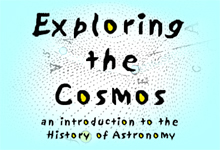

Department of History
University of California, Irvine
Instructor: Dr. Barbara J. Becker
![]()
Lecture 12. Putting Newton's Laws to Work.
![]()
Answering Cosmological Questions |
|
| Newton's law of universal gravitation was put to use by individuals interested in describing the origins of our Sun and its system of planets. | |
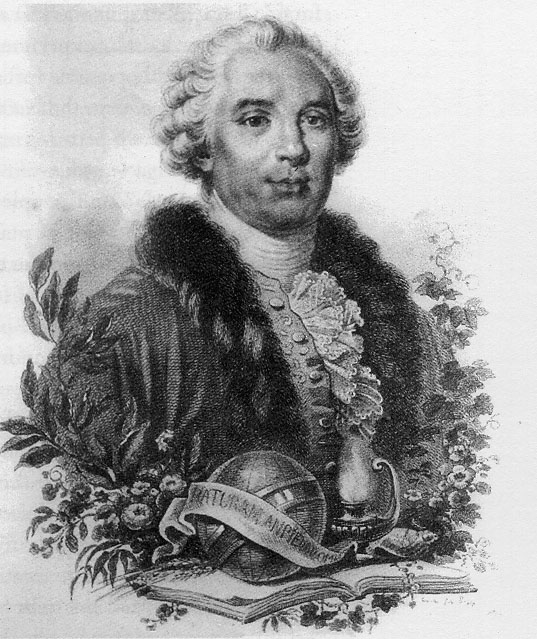 |
Georges Louis Leclerc, Comte de Buffon (1707-1788)
Natural History: General and Particular, vol I (1749) Gravity, therefore, is a general law of nature. The planets, comets, the sun, the earth, are all subject to its laws; and it is the force of that harmony which prevails in the universe. Nothing in physics is better established than the existence of this power in every material body.... |
| [C]omets run through the system in all directions.... The planets,
on the contrary, move round the sun in the same direction, and nearly in
the same plane.... This similarity in the position and motion of
the planets indicates, that their impulsive or centrifugal forces must
have originated from one common cause.
May we not conjecture, that a comet falling into the body of the sun might drive off some parts from its surface, and communicate to them a violent impulsive force, which they still retain? |
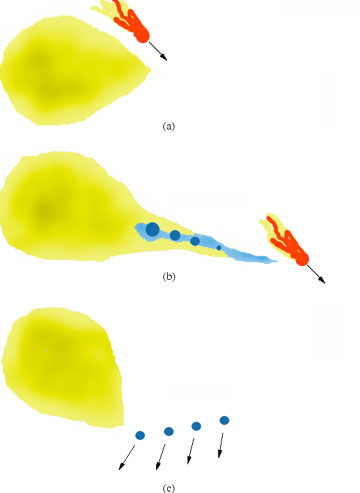 |
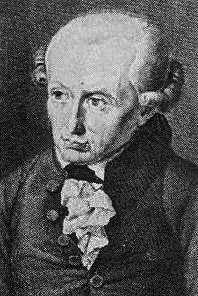 |
Immanuel Kant (1724-1804)
Universal Natural History and Theory of Heaven (1755) The view of the formation of the planets in this system has the advantage over every other possible theory ... the origin of the movements, and the position of the orbits ... even the deviations from the greatest possible exactness ... become clear at a glance. The planets are formed out of particles which, at the distance at which they move, have exact movements in circular orbits; and therefore the masses composed out of them will continue the same movements and at the same rate and in the same direction. |
|
|
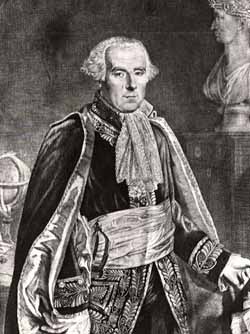 |
Pierre-Simon de Laplace (1749-1827)
The System of the World (1796) Whatever the sun's nature, it must have encompassed all of the planets; and considering the enormous distances separating these bodies, it must have been a fluid of an immense extent. In order to have given the planets almost circular motions in the same direction, this fluid must have surrounded the sun like an atmosphere. The consideration of the planetary motions thus leads us to think that, by virtue of an excessive heat, the solar atmosphere originally extended beyond the orbits of all the planets and that it progressively shrank to its present limits. |

Laplace's nebular hypothesis for the formation of the solar system.
![]()
Solving Planetary Problems |
|||||||||||||||||||||||||||
The Gap Between Mars and Jupiter |
|||||||||||||||||||||||||||
Johannes Kepler (1571-1630) was convinced there was a mathematical plan underlying the structure of the system of planets orbiting the Sun. He was particularly vexed by the challenge of explaining the enormous distance separating the planets Mars and Jupiter. Why is it this way and not otherwise?? In 1702, David Gregory (1659-1708) described the relative distances of the known planets from the Sun as proportional to the numbers: In 1724, philosopher Christian von Wolff (1679-1754) reproduced Gregory's series in a publication that was later read by physicist, Johann Daniel Titius (1729-1796). In 1766, Titius modified the series to create a neat mathematical progression: 4, 7 (= 4 + 3), 10 (= 4 + 6), 16 (= 4 + 12), 52 (= 4 + 48), and 100 (= 4 + 96). Expressing the series this way drew renewed attention to the gap between the 4th and 5th terms. Following the progression's numerical rule, the gap seemed to cry out to be filled by 28 (= 4 + 24). Could there be an as yet undiscovered planet orbiting the Sun at that distance? Titius's series reached a much wider audience after it appeared in the 1772 edition of a popular introductory astronomy text by Johann Elert Bode (1747-1826). Nevertheless, it remained little more than an intellectual curiosity until 1781, when William Herschel announced his serendipitous discovery of a new planet (Uranus) orbiting the Sun at a distance roughly proportional to the next number in the Bode-Titius sequence: 196 ( = 4 + 192)! In 1800, a group of determined astronomers launched a team effort to conduct a systematic search for the missing planet. Meanwhile, a Sicilian astronomer, Giuseppe Piazzi (1746-1826), was pursuing his own research project: using a newly acquired precision sighting instrument to create a new and more accurate star catalogue. On January 1, 1801, he noted the coordinates of a dim and previously unrecorded star. The next night, during a routine check to confirm his previous night's measures, Piazzi found, to his surprise, that this little star had moved! Subsequent observations assured him that the object was not a fixed star, but a satellite of the Sun, perhaps a comet. Piazzi worked at determining the body's orbital path. When comets are near the Sun, their orbits resemble parabolas. But Piazzi found the object did not follow a parabolic path. Instead, its coordinates seemed to fit a near circular orbit with a radius 2.7 times that of Earth's. After Piazzi's discovery was confirmed by other astronomers, he named the new planet Ceres after the Roman goddess of agriculture and patron goddess of Sicily. |
|||||||||||||||||||||||||||
|
|
Attempts to observe and measure Ceres' diameter proved difficult and it soon became clear that this was no ordinary planet, but rather an extremely small body, probably much smaller than the Moon. Then, in March 1802, another new "planet" was discovered by Heinrich Olbers (1758-1840). Named Pallas (after Athena, the Greek goddess of wisdom), this second body was estimated to be even smaller than Ceres, although the two appeared to share roughly the same orbit. William Herschel suggested calling Ceres and Pallas "asteroids" to distinguish them from the rest of the planets. How many of this new breed of solar satellite were out there? Had a larger planet been broken into chunks in some ancient calamitous event? Astronomers searched for signs of more of these tiny celestial bodies. Juno (sister and wife of the Roman god Jupiter) was found in 1804 by Karl Ludwig Harding (1765-1834), and Olbers spotted his second asteroid, Vesta (Roman goddess of the hearth), in 1807. The asteroids' small size made them challenging objects to find, and the next one, Astraea (Greek goddess of justice), was not discovered until 1845, by Karl Ludwig Hencke (1793-1866). In 1847, three more new asteroids were spotted (Hebe, Iris and Flora). After that at least one new asteroid (and usually more) was discovered every year. By 1879, their numbers topped 200, thanks to the addition of twenty new entries that year alone! The list continues to grow. |
The Discovery of Neptune |
In 1845, another planetary puzzle emerged. This one involved the planet Uranus. Although it had only recently been recognized as a planet, Uranus had actually been recorded as a star on maps as early as 1690. Astronomers used this information to track the planet's motion against the background of fixed stars over this lengthy period. They found its actual path deviated significantly from the trajectory prescribed for it by Newton's law of universal gravitation. Were there inaccuracies in the early star maps? Is Newton's law flawed in some way? Or is there, perhaps, another previously unobserved body orbiting the Sun at a distance proportional to the next number in the Bode-Titius series (4 + 384 = 388) that could account for the perturbations in Uranus's orbital path? |
|
|
|
William Herschel discovered Uranus |
Arrangement of the planets at the time Herschel discovered Uranus |
|
|
|
Jean-Baptiste Joseph Delambre (1749-1822) created new tables charting the predicted positions of
planets Jupiter, Saturn, Uranus, and satellites of Jupiter
astronomers observe Uranus moving faster in its orbit than expected |
Planetary Motions (1781-1792)
Changing positions of the planets from 1781 to 1792. The small dots on each planet's path represent one-year increments. Note that Uranus was trailing behind Neptune during this period. Their mutual gravitational attraction slowed Neptune slightly and sped up Uranus. |
|
|
|
Alexis Bouvard (director of Paris observatory; 1767-1843) published more accurate tables for Jupiter and Saturn |
|
|
Bouvard corrected Delambres' tables for Uranus and published new ones. He wrote:
"...I leave it to the future the task of discovering whether the difficulty of reconciling [the data] is connected with the ancient observations, or whether it depends on some foreign and unperceived cause which may have been acting upon the planet." |
Changing positions of the planets from 1821-1832. For reference, the positions of Uranus and Neptune are shown from 1781 (marked off in twenty-year segments). Note that in 1821, Uranus began to overtake and pass Neptune. Once it moved ahead of Neptune, the mutual gravitational attraction of the two planets caused Uranus to start slowing down. |
|
|
|
George Biddell Airy (1801-1892), England's Astronomer Royal, described the problem of Uranus's
orbit as one of the chief problems of astronomy
Uranus had started to slow down in its orbital motion Airy announced that there is evidence that Uranus was observed and recorded on at least 17 occasions before Herschel's discovery; suggested using this information to better describe the peculiarities in Uranus's orbital motion |
| 3 July 1841 | John Couch Adams (1819-1892), while still an undergraduate at
Cambridge, wrote:
"Formed a design in the beginning of this week, of investigating, as soon as possible after taking my degree, the irregularities of the motion of Uranus, which are yet unaccounted for; in order to find out whether they may be attributed to the action of an undiscovered planet beyond it; and if possible thence to determine the elements of its orbit, etc., approximately, which would probably lead to its discovery." |
|
|
Adams derived a first approximation solution |
|
|
French astronomer, Urbain Jean Joseph Leverrier (1811-1877) is encouraged to work on problem of perturbations in Uranus's orbit |
Planetary Motions (1832-1844)
Changing positions of the planets from 1832-1844. For reference, the positions of Uranus and Neptune are shown from 1781 (marked off in twenty-year segments). Note that by 1832, Uranus had passed and moved ahead of Neptune. |
|
| Sept 1845 | Adams deduced a better approximation for the new planet's orbit
assumed a planet to be located about twice the distance from the Sun as Uranus (based on Bode-Titius relationship) took his predictions to Greenwich BUT -- Adams had made no appointment with Airy!! Airy was in France on business at the time. |
| Oct 1845 | Adams tried a second time to see Airy at Greenwich, again without having made an appointment
Airy would not have his dinner interrupted!! (Moral: ALWAYS make an appointment if you want to see the Astronomer Royal!!!) Adams left his manuscript at Greenwich for Airy to read |
| Nov 1845 | after reading Adams' manuscript, Airy wrote to ask Adams about the assumptions he had made in preparing his solution
for whatever reason (hubris, procrastination....?), Adams did not reply (Moral #2: ALWAYS reply when the Astronomer Royal asks you a question!!!) "I could not expect, however, that practical astronomers, who were already fully occupied with important labours, would feel as much confidence in the results of my investigation, as I myself did; and I therefore had our instruments put in order, with the express purpose, if no one else took up the subject, of undertaking the search for the planet myself...." --J. C. Adams |
Nov 1845 &
June 1846 |
Leverrier published two papers on the proposed new planet
after reading these papers, Airy sent the same questions to Leverrier Leverrier responded Airy realized that both Adams and Leverrier were predicting the new planet to be located in the same part of the sky |
|
Where is the new planet? |
|
|
|
Airy told James Challis (1803-1882), director of Cambridge University Observatory, to look for the new planet
"If I were a rich man or had an unemployed staff I would immediately take measures for the strict examination of that part of the heavens containing the position of the postulated planet." --G. B. Airy |
29, 30 July &
4, 12 Aug 1846 |
Challis observed and recorded stars in designated part of sky
recorded but did not recognize that one of those stars was the new planet |
|
|
Leverrier published 3rd paper on new planet
provided full information on its location suggested it may be large enough to see its disk: "It should be possible to see the new planet in good telescopes and also to distinguish it by the size of its disk. This is a very important point ... if a simple study of its physical appearance can replace the rigorous determination of the positions of all the stars, the search will proceed much more rapidly." |
| 18 Sept 1846 | Leverrier wrote to Johann Gottfried Galle (1812-1910) at the Berlin Observatory to ask him to look for new planet |
|
|
Galle and assistant, Heinrich d'Arrest, began their search; they found an uncharted star in 30 minutes! |
Neptun beobachtet [Neptune observed]
"Monsieur, the planet of which you indicated the position really exists." --Galle to Leverrier
"I thank you for the alacrity with which you applied my instructions. We are thereby, thanks to you, definitely in possession of a new world." --Leverrier to Galle |
|
 |
|
| 29 Sept 1846 | Challis finally learned of Leverrier's prediction that new planet
should appear as a disk
looked for and found a disk-like object in the area, but wanted to check this object again to be sure before announcing his discovery |
| 1 Oct 1846 | London Times: "Leverrier's Planet Discovered" |
| What counts as a discovery? | |
|
Who deserves credit for the discovery of Neptune?
|
|
Monsieur Adams searching for the planet of Monsieur Leverrier.
M. Adams discovering the planet in the report of M. Leverrier!
|
|
"I mourn over the loss to England and to Cambridge of a discovery which ought to be theirs every inch of it, but I have said enough about it to get heartily abused in France, and I don't want to get hated in England for saying more." --J. F. W. Herschel (25 Oct 1846) "I do not call finding an individual object merely including it in a crowd of others (without knowing it is there...).... Until the planet was actually seen and shown to be a planet -- there is no discovery -- except in so far as a succesful physical hypothesis is one...." --J. F. W. Herschel (29 Dec 1846) |
|
NOTE: On 12 July 2011, Neptune will soon complete one full trip around its orbit since its discovery in 1846. Because of the complexities of orbital motions, there will actually be three opportunities for earthbound observers to see Neptune situated against the background stars exactly as it appeared when Galle first gazed upon its disk in 23 September 1846: 17 July 2010, 27 October 2011 and 22 November 2011. All Neptunians born on 23 September 1846 will finally celebrate their first birthday! Don't worry if you miss seeing Neptune on this special anniversary. There will be another chance in 165 years. Uranus has circled the Sun over two-and-one-half times since Herschel discovered it in 1781. |
|
|
|